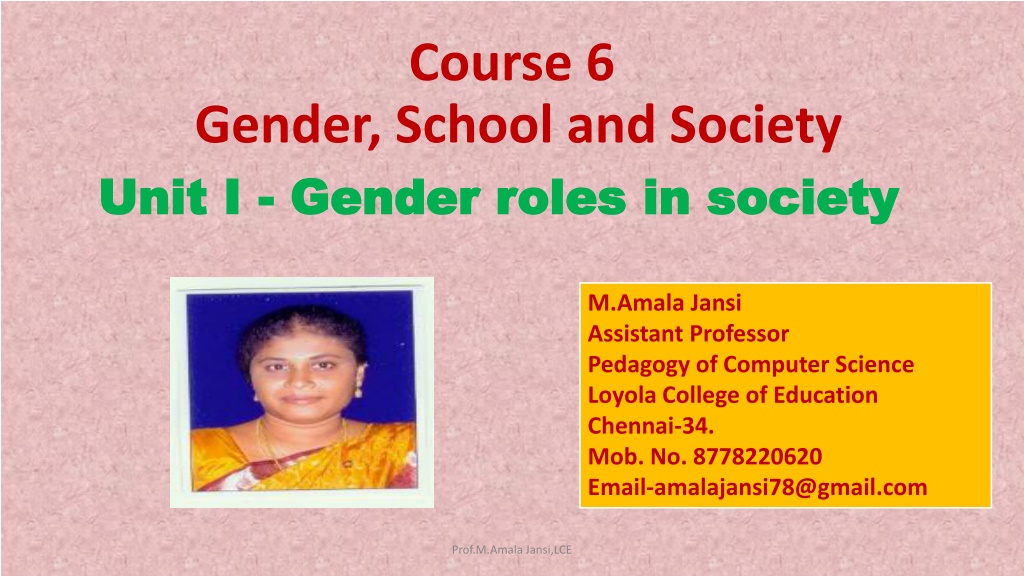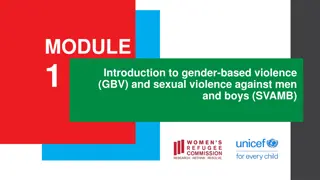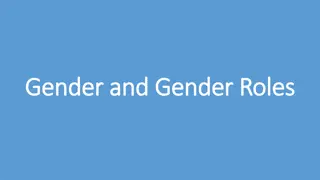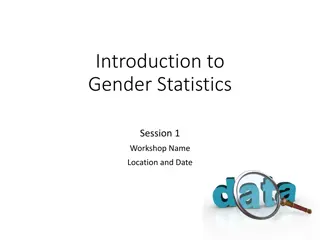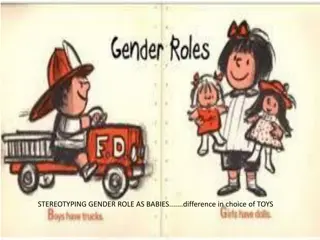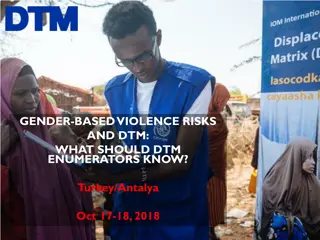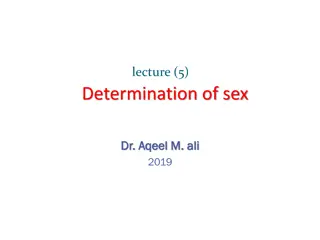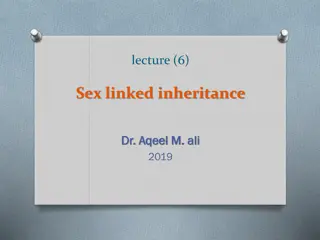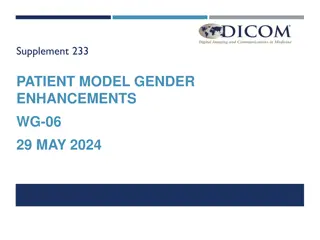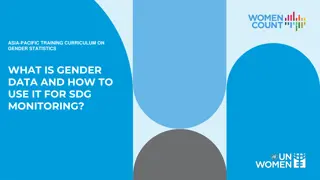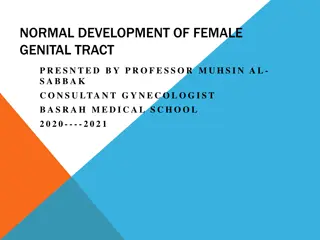Gender Roles in Society: Understanding Sex and Gender
Explore the intricate relationship between sex and gender, uncovering the societal constructs that shape gender roles. Delve into the definitions of sex and gender, and analyze the factors contributing to gender inequalities. Gain insight into gender-just education beyond traditional school settings, presented by Prof. M. Amala Jansi.
Download Presentation

Please find below an Image/Link to download the presentation.
The content on the website is provided AS IS for your information and personal use only. It may not be sold, licensed, or shared on other websites without obtaining consent from the author. Download presentation by click this link. If you encounter any issues during the download, it is possible that the publisher has removed the file from their server.
E N D
Presentation Transcript
Course 6 Gender, School and Society Unit I Unit I - - Gender roles in society Gender roles in society M.Amala Jansi Assistant Professor Pedagogy of Computer Science Loyola College of Education Chennai-34. Mob. No. 8778220620 Email-amalajansi78@gmail.com Prof.M.Amala Jansi,LCE
Gender: Meaning and definition Difference between gender and sex Gender roles in society: family, caste, class, religion, culture, the media and popular culture, law and the state (film, advertisements, songs, etc) Overview Reasons for gender inequalities Gender-just education outside school settings Prof.M.Amala Jansi,LCE
Objectives The learner will be able to Defines Sex and Gender Differentiates Sex and Gender Identifies gender roles in society List outs the reasons for gender inequalities Explains gender-just education outside school settings Prof.M.Amala Jansi,LCE
Sex Sex describes the biological differences between men and women, which are universal and determined at birth. Example Example : : The differences in the organs related reproduction. to Prof.M.Amala Jansi,LCE
Definition of Sex Sex refers to the biological characteristics or natural biological differences between men and women, for example, the differences in the organs related to reproduction. A person s sex is biologically determined as female or male according to certain identifiable physical features which are fixed. Women s marginalization has often been seen as natural and a fact of their biology. Prof.M.Amala Jansi,LCE
Gender Gender refers to the roles and responsibilities of men and women created in our families, our societies and our cultures. that are Prof.M.Amala Jansi,LCE
Definition of Gender Gender refers to the cultural, socially constructed differences between the two sexes. It refers to the way society encourages and teaches the two sexes to behave in different through socialization. Gender and the hierarchical power relations between women and men based on this are socially constructed, and not derived directly from biology. Prof.M.Amala Jansi,LCE
Sex Gender Sex refers to the biological differences between male and female. Gender refers to socially and culturally constructed differences between male and female. individual Sex of an is Gender differences are due to nurture. determined by nature. Sex is Constant, it remains the same everywhere. Gender is Variable ; it changes from time to time, culture to culture , even family to family. Prof.M.Amala Jansi,LCE
Sex Gender Sex cannot be changed without complex medical intervention. Difficult, but not impossible to change. Non-hierarchical. Male and Female are sex categories. Hierarchical. Masculine and Feminine are gender categories. Gender distinctions are created by social norms. Unequally valued. (masculinity as the norms) Learned through socialization. Gender is defined by the personality traits, attitudes, behaviours, values that society ascribes to male and female. Sex is created by the reproduction needs, that is, biological features. Equally valued. Fixed at birth. The individual s external and internal organs, hormonal and chromosomes determine the person s sex. Prof.M.Amala Jansi,LCE
Gender Stereotypes Stereotype is a fixed, general image of a person or thing shared by many people. Gender role stereotyping occurs when a person is expected to enact a series of norms or behaviors based upon their sex. Gender stereotypes are simplistic generalizations about the gender attributes, differences, and roles of individuals or groups. Stereotypes can be positive or negative. Traditionally, the female stereotypic role is to marry and have children. The male stereotypic role is to be the financial provider. Prof.M.Amala Jansi,LCE
Gender roles in society The behaviors of men and women that are considered appropriate are called gender roles. socially Prof.M.Amala Jansi,LCE
Family Gender roles are defined by the socio-cultural norms of any society. In most of the societies the family systems are based on the gender roles. Types of activities, including preference of toys, play styles, discipline, chores, and personal achievements. Prof.M.Amala Jansi,LCE
Today ..The modern Social Structure Prof.M.Amala Jansi,LCE
Gender Roles in Class Lower Middle Upper Prof.M.Amala Jansi,LCE
Religion The main religions of the world all contain certain ideas about the appropriate roles for men and women in society, and traditionally, this has placed women in the home and men in the outside world. The cultural and religious activities that negatively impacted against the education of the girl child were most found. Prof.M.Amala Jansi,LCE
Culture & Popular Culture The term popular culture was coined in the 19th century or earlier. The abbreviated form pop for popular. For example: Generally, super heroes are men. Women always expect to rescue. Culturally determined gender ideologies define rights and responsibilities and what is appropriate behaviour for women and men. Expectations about attributes and behaviours appropriate to women or men and about the relations between women and men in other words, gender are shaped by culture. Prof.M.Amala Jansi,LCE
Media The main aim of mass media is to be universal and suitable for everyone, in order to gather the largest possible audience. Mass media not only gives people information and entertainment, but it also affects people s lives by shaping their opinions, attitudes and beliefs. Portrayed-gender stereotypes. Prof.M.Amala Jansi,LCE
Advertisement Men generally advertise cars, cigarettes, business products or investments, whereas women are shown rather in the commercials with cosmetics and domestic products. Prof.M.Amala Jansi,LCE
Films The Bollywood films have well portrayed the changes happening in the society the films has always been criticized for its almost ignoring the issues of gender. Prof.M.Amala Jansi,LCE
Law and State: Law is pervasive and affects many aspects of people s lives, women and men alike. Inequalities in endowments, access to resources and rights, social (and household) status, voice and agency are perpetuated, codified, contested and redressed through norms and the institutions established or resulting from such norms, be they social or legal. Prof.M.Amala Jansi,LCE
Gender Inequality Gender inequality is the unequal treatment or perceptions of individuals based on their gender. It arise from differences in socially constructed gender roles. Prof.M.Amala Jansi,LCE
Important causes of gender disparity Poverty Illiteracy Lack of Employment Facilities Social Customs , Beliefs and Practices Social Altitude Lack of Awareness of Women Prof.M.Amala Jansi,LCE
Reasons for gender inequalities in India Education Religious belief Weaker Sex Lack of resources Lack of awareness Giving importance to male child Dowry system Other reasons : Due to diversity on many counts like differences in ideas , opinion , language , colour , region and caste. Prof.M.Amala Jansi,LCE
HOW TO REDUCE INEQUALITY: IN EDUCATION Offering high level education Social integration Increasing women employment Involving them in active politics and social activities Arranging social protection programs Generating awareness among parents Giving scholarships to girls Others Policies, recommendations and initiatives for gender equality Welfare Programmes and Policies for Women by Government Policies of the Government Prof.M.Amala Jansi,LCE
Gender-just education outside school settings Agency of Education: Formal: This includes institutions deliberately set up by the society with specific objective of carrying out the various functions of education. Ex: the school Informal: This includes institutions which perform educational functions just incidentally and indirectly. Ex: Family , peer group, youth clubs Non-formal Education (NFE) is any organized educational activity that takes place outside the formal educational system. Usually it is flexible, learner-centered, contextualized and uses a participatory approach. There is no specific target group for NFE; it could be kids, youth or adults. Ex:NGOs. Prof.M.Amala Jansi,LCE
Questions for Discussion and Reflection Differentiate gender and sex. Explain the various gender roles in society. Discuss the reasons for gender inequalities and effective ways to remove inequality. What is the status of gender equality in present India? Prof.M.Amala Jansi,LCE
Future Reading.. Lippa , Richard A. 2002. Gender, Nature, and Nurture. Mahwah, NJ: L. Erlbaum. Oakley, Ann. 1972. Sex, Gender, and Society. New York: Harper and Row. Thorne, Barrie. 1993. Gender Play: Girls and Boys in School. New Brunswick, NJ: Rutgers University Press. Website: http://www.ekvilib.org/wp- content/uploads/2017/06/01_Gender_Concepts.p df https://digitalcommons.library.umaine.edu/cgi/vie wcontent.cgi?article=1000&context=soc_facpub Prof.M.Amala Jansi,LCE
